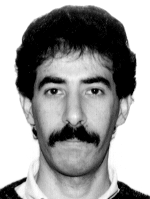
![[GlobalNews Home]](../globe.gif)
![[Prev Page]](/images/arrow-left.gif)
![[Next Page]](/images/arrow-right.gif)
Hussein Almuallim

Hussein Almuallim received his BS in physical electronics and his MS in computer science from Takushoku University-Tokyo. His Masters work was on the recognition of handwritten connected characters. He then returned to Saudi Arabia to work as a lecturer in the University of Petroleum and Minerals. In 1987, he moved to Oregon State University (U.S.A.) where he obtained his PhD from the Department of Computer Science in 1992. His PhD work was in the field of artificial intelligence, with a focus on machine learning.
After his PhD, he joined the Knowledge Systems Lab at NTT's Network Information Systems Labs in Yokosuka as a post-doctoral researcher. There, his research is targeted at utilizing inductive machine learning techniques in solving problems encountered in the construction of large scale machine translation systems. Hussein's plan is to return to the University of Petroleum and Minerals in Saudi Arabia as an assistant professor in the Department of Information and Computer Science.
Hussein enjoys swimming, skiing, and playing "u'ud" (a popular Arabian music instrument, very similar to the "lute").
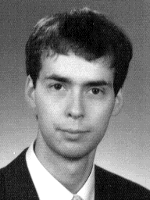
Thomas Bever obtained his diploma in physics at the Technische Universität München (Germany) in 1989. For his diploma work he spent one year in the department of physics of the Universitetet i Lund (Sweden). There he investigated point-defects in silicon using a fourier spectrometer.
From Lund he changed to the Max-Planck-Institut für Festkörperforschung in Stuttgart (Germany) where he fabricated small structures in semiconductors by means of focused ion beam implantation. In 1992 he received his PhD from the Universität Stuttgart (Germany).
He came to NTT in October 1992 to join the Physical Science Research Group in the Basic Research Laboratories. In the group of Dr. Tarucha, he works on the fabrication of quantum wires using focused ion beams and molecular beam epitaxial overgrowth.
Thomas is married with one child.
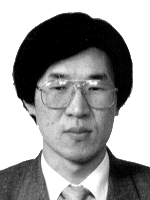
Chang-Joon Chae received his BE from Hankuk Aviation University in 1981, and an ME and PhD from Korea Advanced Institute of Science and Technology in 1984 and 1989, respectively. His thesis work was to design an integrable semiconductor laser and fabricate an optoelectronic integrated circuit. He joined Korea Telecom Research Center in 1989 and worked on the development of optical subscriber transmission system (optical digital loop carrier) until he came to Japan. He is now doing research on the topology of optical subscriber transmission networks at NTT Transmission Systems Laboratories as a visiting researcher. He will return to Korea in October, 1993.
Chang-Joon is married with two sons, 3 and 1 years of age, and lives with them at Yokosuka City. His interests include climbing (not in Japan), reading scientific materials, and going around the city.
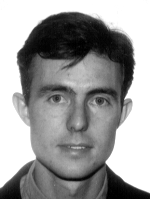
Edouard Geoffrois graduated in 1990 from the Ecole Polytechnique, one of the French "Grandes Ecoles" or Scientific Engineering Schools. He received his MS in cognitive science from the Université d'Orsay, then began his PhD in speech recognition at the LIMSI, a CNRS lab located on the Université d'Orsay campus. Both the Ecole Polytechnique and the Université d'Orsay are located in a south suburb of Paris.
During his Masters research, he concentrated on auditory information processing in the brain, then returned to auditory information processing in the computer (i.e., Speech Recognition). Now he develops algorithms for using intonation in recognition systems in order to discriminate between phrases like, "That is insight" and "That is in sight." He is on leave from the LIMSI to the Furui Group in NTT Human Interface Labs until September '93.
Being committed to the idea that student exchanges are the best way to improve mutual understanding between Japan and other countries, he is in charge of the traineeships in Japan for the students of the Ecole Polytechnique.
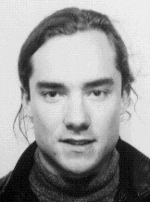
Terence Gilhuly is currently a student at the University of Waterloo in Ontario (Canada). He is a third year student working toward a degree in systems design engineering specializing in electrical engineering topics such as integrated circuits and communications theory.
Terence is taking a one year leave from engineering to seize the opportunity of working for NTT's Photonic Switching Group. His research here will last for six months, then he will look for other work until classes reconvene in January of 1994.
Terence's family (two parents, three brothers, one sister, and two dogs) also live in Waterloo, Ontario. When not participating in his family's many activities, Terence finds himself pursuing interests from sports (football, soccer, hockey, billiards, martial arts, chess... almost anything), to computers, to electronics, to reading, to listening to music, to amateur (very amateur) astronomy. Terence is a member of IEEE and CASI (Canadian Aeronautics and Space Institute) and hoping to become an insomniac.
Jungtae Lee obtained his BA at Pusan National University (Republic of Korea) in electronic engineering, 1976. After graduating, he joined ETRI (Electronics and Telecommunications Research Institute) and worked there until 1985, studying data communications, packet switching networks, and local area networks.
In 1989, he received a PhD at Seoul National University, in computer engineering, with a thesis on a data communication protocol using voice silence time. Now he is an associate professor at Pusan National University, where he gives lectures on computer networks and data communications. Jungtae has also studied very high speed protocols, BISDN, multimedia networks, and PCN (Personal Communication Networks).
Last year, he joined the NTT Telecommunication Networks Laboratories, Yokosuka, as a visiting researcher for one year, where he has continued his work on very high speed multimedia protocols.
Jungtae is a member of IEEE, ACM, and KISS (Korean Information Science Society). He has two children, 15 and 10 years of age. He likes swimming, mountain climbing, and playing the game of go.
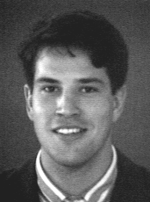 Robert A. Lemos was born in Dover, New Hampshire (U.S.A.) in Showa 43.
Throughout his childhood, he played ice hockey and watched the cows chew grass
on the hillside near his home. After graduating from Cornell University in
August 1990 with a BS in electrical engineering, Rob came to Japan to do
research.
Robert A. Lemos was born in Dover, New Hampshire (U.S.A.) in Showa 43.
Throughout his childhood, he played ice hockey and watched the cows chew grass
on the hillside near his home. After graduating from Cornell University in
August 1990 with a BS in electrical engineering, Rob came to Japan to do
research.
In August 1991, Rob began working for NTT in the Sensing Systems Research Group of the Interdisciplinary Labs. He is currently an employee of NTT-Intelligent Technology Co., Ltd. of Yokohama. His research includes using pattern recognition algorithms to recognize chemical vapors and odors.
Rob will attend the InterUniversity Center in Yokohama starting in September to study Japanese useful for his research. After that, he will return to the United States for graduate school. His other interests include neural networks, evolutionary computing, environmental science, and dancing.
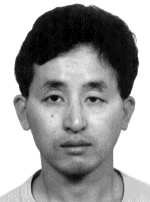
Franklin Massami Matinaga obtained his BA at the Universidade de São Paulo (Brazil) in physics, and the PhD at the Universidade de Campinas - São Paulo (Brazil) also in physics. He joined the CPqD (Research Laboratory of the Brazilian Telephone Company) in 1990.
After that, he came to NTT's Basic Research Laboratories as a postdoctoral fellow in October 1991. He has been working with microcavity lasers and has interests in cavity quantum electrodynamics and quantum optics as well as in semiconductor physics.
Last year, Franklin and Henrich Heitmann earned one of the prestigious R&D prizes from NTT for their research on low threshold semiconductor lasers.
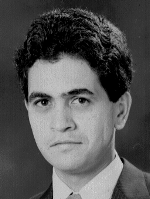
Farzin Mokhtarian received his BS in mathematical sciences from Johns Hopkins University (Baltimore, Maryland, USA) in 1982. He then moved to Canada and received his MS in computer science in 1984 from the University of British Columbia in Vancouver. From 1984 to 1985, he worked at the Schlumberger-Doll Research Lab in Ridgefield, Connecticut (U.S.A.) where his work focused on 2-D and 3-D seismic image processing. The goal was to locate geological features such as faults, salt domes, and reservoirs to aid in the detection of oil. He returned to Vancouver in 1985 and received his PhD in computer science in 1990 from the University of British Columbia. Computer vision was his area of specialization. Upon completion of his PhD, he taught courses in artificial intelligence and computer architectures at UBC.
He is now a member of the Naito group in the Information Science Research Laboratory, NTT Basic Research Laboratories, which he joined in October 1991. His research at NTT has been on 2-D and 3-D object recognition using curvature and torsion scale space representations developed while working on his PhD thesis.
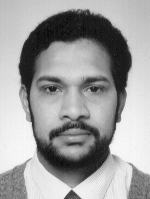 Kuniyil Prabhakaran was born in 1961 in Kerala (India), where the native
language is Malayalam. The name Prabhakaran means 'sun' in Malayalam. After
completing his BS and MS in chemistry at the University of Calicut in Kerala,
he joined the Solid State and Structural Chemistry Unit at the Indian Institute
of Science located in Bangalore (India). He was awarded his PhD in 1989 for
research on molecular interaction on transition metal surfaces and modification
of surface properties by over-layer deposition. Later on, he worked at the
Synchrotron Radiation Laboratory in Daresbury (England) under a joint program
of the Universities of Manchester and Liverpool.
Kuniyil Prabhakaran was born in 1961 in Kerala (India), where the native
language is Malayalam. The name Prabhakaran means 'sun' in Malayalam. After
completing his BS and MS in chemistry at the University of Calicut in Kerala,
he joined the Solid State and Structural Chemistry Unit at the Indian Institute
of Science located in Bangalore (India). He was awarded his PhD in 1989 for
research on molecular interaction on transition metal surfaces and modification
of surface properties by over-layer deposition. Later on, he worked at the
Synchrotron Radiation Laboratory in Daresbury (England) under a joint program
of the Universities of Manchester and Liverpool.
Since November 1991, he has been working in the Ogino group of NTT Basic Research Laboratories. His current research interests are in the area of atomic level control of events on the surfaces of SiGe based materials. His wife Geetha and two year old son Arjun live with him in Japan. His hobbies are mainly listening to folk songs, reading, and playing with children.
Nicolas Raguideau is a Graduate Engineer from Ecole Supérieure d'Electicité in France, 1989. After working at "Télésystèmes" in Paris on the development of a communication server for secured transactions, he came to Japan in 1990 as an assistant of the Science and Technology Counselor at the French embassy in Tokyo. He was also member of OITDA, a Japanese national association for studies and promotion of optoelectronics.
Nicolas then joined NTT's Communication Switching Laboratories at Musashino in June 1992 as an invited researcher with a SFPJ fellowship from the European Community. He is working in the Maruyama Group on a distributed processing platform for communication network applications, and is more specifically concerned with open call processing design based on concurrent object oriented models.
He likes nigirizake, traveling, and does not know when he will return to France.
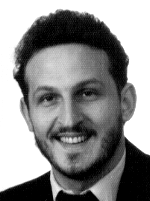 Gerhard Rigoll finished his studies in cybernetics and received the Dipl.-Ing.
degree from the University of Stuttgart in Germany in 1982. From 1982 to 1986
he worked at the Fraunhofer-Institute in Stuttgart conducting contract research
in artificial intelligence and speech processing for the department of advanced
information and communication technologies. He received the Dr.-Ing. degree in
1986 in automatic speech recognition. From 1986 to 1988 he was a visiting
scientist at the IBM Thomas Watson Research Center in Yorktown Heights, USA,
where he continued his activities in speech and pattern recognition. He
returned to the Fraunhofer-Institute in 1988 and became head of a research
group with activities in artificial intelligence, speech processing and pattern
recognition. In January 1991 he received the Dr.-Ing. habil. degree from the
University of Stuttgart and shortly afterwards he came to Japan to join the NTT
Human Interface Laboratories as a visiting scientist in neurocomputing and
speech recognition.
Gerhard Rigoll finished his studies in cybernetics and received the Dipl.-Ing.
degree from the University of Stuttgart in Germany in 1982. From 1982 to 1986
he worked at the Fraunhofer-Institute in Stuttgart conducting contract research
in artificial intelligence and speech processing for the department of advanced
information and communication technologies. He received the Dr.-Ing. degree in
1986 in automatic speech recognition. From 1986 to 1988 he was a visiting
scientist at the IBM Thomas Watson Research Center in Yorktown Heights, USA,
where he continued his activities in speech and pattern recognition. He
returned to the Fraunhofer-Institute in 1988 and became head of a research
group with activities in artificial intelligence, speech processing and pattern
recognition. In January 1991 he received the Dr.-Ing. habil. degree from the
University of Stuttgart and shortly afterwards he came to Japan to join the NTT
Human Interface Laboratories as a visiting scientist in neurocomputing and
speech recognition.
Stéphane Soteg Somé was born and raised in Burkina Faso, Africa. In 1986, he joined the Institut Africain d'Informatique (IAI) in Libreville, Gabon where he completed a Programmer Analyst degree in 1989. From 1989 to 1992 he was working toward his MS in computer science at the University of Montreal (Canada) with research in distributed object oriented programming. He is now pursuing a PhD in computer science at the University of Montreal. His actual research concerns requirements for communication systems protocols.
Stéphane came to Japan for a three month period as a trainee at NTT's Software Engineering Laboratories working on incremental specification of communication protocols. His other activities includes hiking, camping and listening to classical music.
Chung-Huang Yang received his BS in electrical engineering from the National Cheng-Kung University (Taiwan). He then received both his MS and PhD in computer engineering from the Center for Advanced Computer Studies, University of Southwestern Louisiana (U.S.A.). His graduate work was on the design and analysis of cryptographic algorithms. After graduating, he was with the Destiny Technology Corp. and RSA Data Security Inc. in California (U.S.A.) before he joined NTT Network Information System Labs at Yokosuka in September 1991.
He is working now as a postdoctoral fellow in the Miyaguchi Group, where he conducts work on the design of high-speed arithmetic algorithms and the implementation of cryptographic algorithms on smart cards.
![[GlobalNews Home]](../globe.gif)
![[Prev Page]](/images/arrow-left.gif)
![[Next Page]](/images/arrow-right.gif)